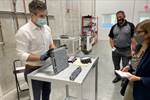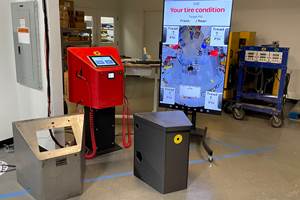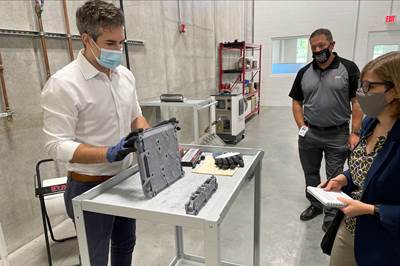Share
Read Next
The U.S. Department of Defense is potentially heading toward a supply chain problem. The DOD has committed numerous resources to its own forces and those of allies worldwide, including unmanned aerial vehicles (UAVs), drones and longer range weapons. Many of these items require specialized, small-scale jet engines, with most having been designed around engine models that were developed decades ago. These key components could be a significant bottleneck to maintaining and ramping up future stores of this aerial military hardware.
One reason: Many of the legacy small-scale engines depend on investment casting and/or forging, both processes that rely (and can be hindered by their reliance) on long lead time tooling. Coupled with limited available casting capacity in the U.S., this dependence might mean that conditions are developing for an engine shortage — and a lapse in the defense technology supply chain.
Beehive Industries aims to prevent this from happening, and plans to help fill the coming need with newly developed small-scale engines of its own design, only possible through additive manufacturing.
Once a manufacturer serving outside clients, Beehive Industries is now devoted to developing and scaling small engines with significantly lower part counts but a high percentage of 3D printed content. The bulk of this 200-lb-thrust engine is made from just five metal 3D printed parts.
“We're solving the problem of affordable mass for the Department of Defense,” says Gordie Follin, chief product officer.
“Affordable mass,” is a concept that calls for balancing cost and capabilities in military programs to achieve higher munitions stock levels (as opposed to focusing on highly capable munitions that are so costly and time consuming to produce that inventory is quickly depleted when consumed); the term has been particularly associated with autonomous drones and precision-guided weapons. Should a significant conflict arise, the U.S.’s existing stores could quickly run low and need to be replaced. Over the next 10 to 15 years, Follin says, more than 100,000 munitions could be needed.
The catch, of course, is that these new munitions will need to meet mission requirements while also being delivered more quickly and at lower cost than the conventional ones obtained in the past. To meet the need, Beehive Industries is working toward more affordable engines that can be produced more quickly, enabled by additive manufacturing.
I learned about Beehive Industries’ business during a visit to the company’s Englewood, Colorado, facility where I met (left to right) chief product officer Gordie Follin, director of operations Keren Callin, VP of business development Scott Williams, and (not pictured) chief operations officer Darius Ehteshami and VP of manufacturing programs Julie Vaccaro.
Next-Generation Small-Scale Engines
Beehive’s 500-lb-thrust demonstrator is composed of 14 metal 3D printed parts (compared to thousands used in a traditionally manufactured design), supplemented with off-the-shelf seals, bearings and fasteners.
Beehive Industries was originally launched as an AM-focused contract manufacturer and still performs some work for outside clients. But since its founding in 2020, the company has morphed from service provider into original equipment manufacturer. Instead of producing parts for others, the company's primary activity is now developing, testing and proving out engines of its own design, which rely on a large percentage of 3D printed content.
Beehive has two such products in development as of 2024. Its first is a 500-lb demonstrator that is scalable to 1,000 lbs of thrust. This engine is an analog to one already in use in certain cruise missiles and large drones. However, where the legacy engine consists of more than 2,000 parts, the Beehive version is just 140. Most of this part count is made up of off-the-shelf commodity items like seals, bearings and fasteners. The key components are the 14 3D printed metal parts that together form the bulk of the engine, taking the place of numerous investment cast, forged and/or machined parts.
When I visited the company’s Englewood, Colorado, headquarters (near Denver) in May 2024, this engine had recently completed operational testing and was disassembled for postmortem inspection and testing.
Members of the team were already talking about improvements to be made in the next go-round — but these were remarkably small tweaks, for instance changing a rope seal interface to one printed directly into the flange to avoid a step in assembly. The next engine test is schedule to be run in late 2024.
Design changes like this, which can dramatically simplify downstream manufacturing, are fast and inexpensive with AM — and the ability to modify the parts easily in development evidently played a role in the success of the first tested engine. The 500-lb-thrust engine was developed, from design to test ready, in just 13 months.

David Kimball, VP of engineering, and Scott Williams, VP of business development, stand behind the bench where the 500-lb demonstrator engine has been disassembled following successful testing. When I visited in May, the focus was on additional design tweaks to reduce part count and improve performance even further via changes to the AM parts.
“There are no upstream changes to molds or castings,” says David Kimball, vice president of engineering. Free from the upstream tooling that would be needed for a design dependent on castings, Beehive has been able to move quickly and be agile in developing its engines.
The second product that Beehive Industries has underway is a smaller, 7-inch-diameter engine designed for use in air-launched cruise missiles that can be fired from a piloted or unpiloted aircraft. This 200-lb-thrust engine again is an analog to an existing engine option but has the benefit of containing many fewer parts — in this case, requiring just five 3D printed metal components.
Beehive’s smaller engine prototype (shown assembled at the top of this article) is primarily composed of five parts produced through laser powder bed fusion.
Aiming for Scale
The reasons to 3D print parts for these engines include speed of development and production; a reduction in part count and processes; and also lower cost.
A comparable small-scale engine (100- to 200-lb thrust class) made with investment casting and other more conventional technology can often exceed $70,000. Beehive is aiming for an engine that is half that cost while offering better fuel efficiency.
The saving derives primarily from assembly consolidation, but not in the way that might be obvious. Reducing part count does reduce labor and time spent in assembly, but it reduces something else as well: subcontractors and suppliers, each of which adds cost to the manufacturing process. The supply chain becomes shorter and more manageable with fewer individual contractors involved.
“We're reducing part count for the 500-lb engine by 90%,” says Scott Williams, vice president of business development. “It's more affordable because we're avoiding sub-suppliers, and they’re not producing inventory awaiting assembly, and in turn, we mitigate risks in the supply chain.”
Shown above is an early combustor liner prototype for Beehive’s 500-lb-thrust demonstrator engine. Beehive built and tested five design iterations in a matter of months, which the company says contributed to a more successful and informative engine test.
There are performance gains to be had through AM as well; in addition to consolidation, Beehive is also leveraging additive manufacturing’s geometric capabilities to create engines that work better. The first-stage impeller for the 500-lb-thrust engine for example features a novel design not possible with traditional manufacturing methods, which contributes to 20% greater efficiency. Its unusual geometry, designed to improve the airflow and therefore the efficiency of the engine, is an improvement made possible and affordable only with additive manufacturing.
This 500-lb-thrust engine underwent more than 35 starts in testing, providing evidence that an engine design which depends on additive parts can succeed. Now the task is to continue to tweak and improve this product, while also demonstrating its manufacturing scalability.
A goal for 2024, Follin says, is to produce 40 of the smaller, 100-lb-thrust class engines within a week. This would serve as a capacity proof point for the company’s goal of being able to produce 2,000 engines in a year. Successful completion of this demonstration will be one more hurdle cleared toward getting these engines into unmanned aerial vehicles and munitions, to help shore up military stores.
Director of operations Keren Callen (far right) and David Kimball show me around the engine test cell that Beehive Industries constructed itself. Earlier in the year, its 500-lb demonstrator engine was run from start to various operational levels nearly three dozen times inside this space.
Vertically Integrated, Modular Manufacturing
Laser powder bed fusion (LPBF) is performed on machines from EOS in two different sizes, in materials including titanium, aluminum and nickel alloys.
The company is currently in conversation with various DOD representatives and stakeholders to get its engines into vehicles, and looking to scale up its production capacity accordingly with a vertical integration mindset.
This HB800 EDM from EDM Performance Accessories uses a molybdenum wire to cut printed parts from their build plates.
In Englewood the company has laser powder bed fusion (LPBF) 3D printing, primarily via machines from EOS; molybdenum wire EDM (EDM Performance Accessories) and bandsaw (Behringer Saws) capacity for part cut-off; CNC machine tools from Okuma for part finishing operations and build plate refinishing; and a quality assurance lab for verifying dimensional aspects of parts.
(A materials lab located in Cincinnati, Ohio, handles metallurgy needs.) Generally, parts leave the facility only for heat treat or HIPing, and in some cases for chemical milling — but these processes (or alternatives to them) could one day be brought in-house as volume grows.
Today many of the steps in the AM workflow described above take place in different places within the Englewood building, but the team is looking at how to develop production “modules” that will consist of smaller collections of grouped equipment. Tape across the floor marks out where new and existing equipment will soon be arranged into these modules, which will enable parts to go straight from 3D printing into machining and inspection within a compact space. The idea is to create end-to-end modules that are easy to replicate in other locations as production increases, including perhaps even placing manufacturing capacity closer to conflict. Modular manufacturing directly supports the DOD’s request for what it calls “distributed logistics,” Beehive says, to mitigate supply chain risk and cost, ultimately putting supplies into the hands of the warfighter faster.
“Once you’ve designed the part and locked in the parameters, it’s very easy to scale,” Follin says.
That’s a key advantage that additive manufacturing brings over traditional production methods such as casting. Only a limited number of foundries are available in the United States, and adding capacity to these operations is difficult, expensive and time-consuming. With additive manufacturing, Beehive’s capacity to scale will be as simple as adding new modules to support increased demand in a more responsive way.
“We don’t need to stockpile castings,” Follin says. “We just need to store powder, and design around off-the-shelf components.”
For now, all the distinct steps in the additive manufacturing process (printing, part cut-off, machining, inspection) happen in different locations within the building. But soon, equipment will be grouped together in modules that can take a part from print through inspection within a smaller footprint. The blue tape on the floor marks where machines will one day be placed or relocated.
Reworking the facility floor around scalable production modules also entails rethinking workforce and training. Beehive Industries currently employs more than 200 people across its four locations in Colorado, Tennessee and Ohio. Most employees are mid-career and experienced, and many are alumni of companies either focused on propulsion or specializing in additive manufacturing. While in other contexts this might result in a significant sense of separation between the propulsion-focused engineers and the AM-focused manufacturing staff, at Beehive both teams are constantly interacting.
“Everyone is cross trained,” says Keren Callen, director of operations, and this will be increasingly important as the modules come online. Employees won’t be specialists, but must be skilled in each step within the cell.
Additive for Distributed Logistics
Scaling up with production modules is possible because of additive manufacturing’s freedom from molds and other tooling, but the concept also brings the opportunity for supply chain redundancy and distributed logistics, where capacity is spread across multiple physical locations.
“You diversify the target set,” Williams says. “It’s a modular supply chain.”
“AM represents big potential in a compact footprint,” Kimball adds. That makes it easier to spread production around: “It’s capacity density.”
Beehive already has more than 30 metal 3D printers distributed among its facilities. As the company moves out of development and toward ongoing production for its small-scale engines, that number will grow — and at an accelerated pace if conditions demand.
“We are building the capacity to surge,” Williams says.
Related Content
Faster Iteration, Flexible Production: How This Inflation System OEM Wins With 3D Printing
Haltec Corp., a manufacturer of tire valves and inflation systems, finds utility in 3D printing for rapid prototyping and production of components for its modular and customizable products.
Read MoreAt General Atomics, Do Unmanned Aerial Systems Reveal the Future of Aircraft Manufacturing?
The maker of the Predator and SkyGuardian remote aircraft can implement additive manufacturing more rapidly and widely than the makers of other types of planes. The role of 3D printing in current and future UAS components hints at how far AM can go to save cost and time in aircraft production and design.
Read MoreDyndrite Joins NMIS to Advance 3D Metal Manufacturing Research
Dyndrite has joined NMIS to help develop build recipes and shareable knowledge in materials process development across all major laser powder bed fusion OEM file formats.
Read MoreRead Next
Preassembled Turbojet Engine, 3D Printed in One Build: The Cool Parts Show #75
Turbojet engines typically consist of hundreds or thousands of parts, but this engine — 2023 winner of The Cool Parts Showcase for Best Proof of Concept — was 3D printed as just two pieces, with the monolithic rotor embedded inside the stationary engine shell.
Read MoreAdditive Manufacturing for Rail Industry Is Gaining Traction at Neighborhood 91
Locomotive manufacturer Wabtec is the first tenant of Pittsburgh’s N91 additive manufacturing ecosystem, where the company is ramping up production via laser powder bed fusion.
Read More3D Printed Titanium Replaces Aluminum for Unmanned Aircraft Wing Splice: The Cool Parts Show #72
Rapid Plasma Deposition produces the near-net-shape preform for a newly designed wing splice for remotely piloted aircraft from General Atomics. The Cool Parts Show visits Norsk Titanium, where this part is made.
Read More

.jpg;width=70;height=70;mode=crop)






























